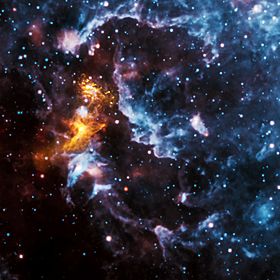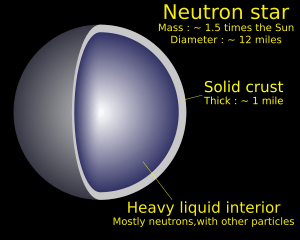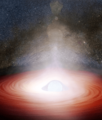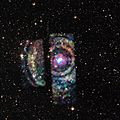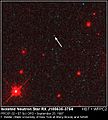Neutron star facts for kids

A neutron star is a very small and dense star made almost completely of neutrons. They are small stars with a radius of about 11–11.5 kilometres. They have a mass of about twice that of the Sun. They are the smallest and densest stars known to exist in the Universe. They are what is left of a huge star which exploded as a supernova.
The density of the star is like that of the nucleus of an atom. They have strong magnetic fields, between 108 and 1015 times as strong as that of Earth.
To imagine how dense a neutron star is, take all of the mass of our sun (which has a diameter of 1,392,000 kilometres (865,000 mi)) and push it down into a size that would fit into a ball with a 19 kilometres (12 mi) diameter. Another way to understand the density is this: one teaspoon of matter from the neutron star would weigh 6 billion tons.
Neutron stars spin very fast, from 0.001 second up to 30 seconds to turn. They come in different types. They may emit beams of electromagnetic radiation as pulsars. Other types are magnetars and binary pulsars.
They are more than 600,000 degrees Kelvin in temperature. Neutron stars that can be observed are very hot and typically have a surface temperature of around 600000 K.
Contents
Formation
When a massive star exhausts its nuclear fuel, its core collapses under its own gravity. This collapse happens incredibly fast. The outer layers of the star fall inward, bounce off the core, and explode outward, creating a supernova. The core, if it has between about one and three times the mass of our Sun, will become a neutron star. If the core is heavier, it will collapse further to form a black hole.
What's inside a neutron star?
A neutron star is mostly made of neutrons, but it also has other stuff:
- Crust: The outer layer is a solid crust made of heavy elements like iron.
- Outer Core: Below the crust, there's a liquid ocean of neutrons.
- Inner Core: The center might have exotic stuff like quarks or other weird particles.
History
In 1934, Walter Baade and Fritz Zwicky proposed the existence of neutron stars, only a year after the discovery of the neutron by James Chadwick.
Looking for the origin of a supernova, they suggested that in supernova explosions ordinary stars are turned into stars that consist of extremely closely packed neutrons, which they called neutron stars. Baade and Zwicky suggested that the release of the gravitational binding energy of the neutron stars powers the supernova: "In the supernova process, mass in bulk is annihilated".
Neutron stars were thought to be too faint to be detectable. Little work was done on them until November 1967, when Franco Pacini (1939–2012) pointed out that if the neutron stars were spinning and had large magnetic fields, then electromagnetic waves would be emitted. Radio astronomer Antony Hewish and his research assistant Jocelyn Bell at Cambridge soon detected radio pulses from stars that are now known as pulsars.
Future
Over millions or billions of years, neutron stars will gradually cool down and slow their rotation. Eventually, they will become cold, dead remnants in space. However, they will continue to exert their strong gravitational pull on any nearby objects.
Interesting facts about neutron stars
- They're called neutron stars because they're mostly made of neutrons, which are tiny parts of atoms.
- Neutron stars are born when a big star runs out of fuel and goes boom in a supernova!
- Newly formed neutron stars may have surface temperatures of ten million K or more.
- One teaspoon (5 milliliters) of its material would have a mass over 5.5×1012 kg, about 900 times the mass of the Great Pyramid of Giza.
- The gravitational field at the neutron star's surface is about 2×1011 times stronger than on Earth. If you dropped something from just one meter above the surface, it would hit the ground in a tiny fraction of a second, going incredibly fast.
- Because of the enormous gravity, time dilation between a neutron star and Earth is significant. For example, eight years could pass on the surface of a neutron star, yet ten years would have passed on Earth, not including the time-dilation effect of the star's very rapid rotation.
- A newborn neutron star can rotate many times a second.
- The most rapidly rotating neutron star currently known, PSR J1748-2446ad, rotates at 716 revolutions per second.
- The magnetic fields of neutron stars can be trillions of times stronger than Earth's magnetic field.
- At present, there are about 3,200 known neutron stars in the Milky Way and the Magellanic Clouds, the majority of which have been detected as radio pulsars.
- The Neutron Star Interior Composition Explorer (NICER) is an instrument on the International Space Station that studies neutron stars by observing their X-rays.
Images for kids
-
P–P-dot diagram for known rotation-powered pulsars (red), anomalous X-ray pulsars (green), high-energy emission pulsars (blue) and binary pulsars (pink)
-
Circinus X-1: X-ray light rings from a binary neutron star (24 June 2015; Chandra X-ray Observatory)
See also
 In Spanish: Estrella de neutrones para niños
In Spanish: Estrella de neutrones para niños


